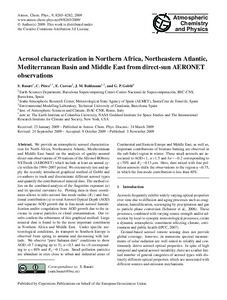Por favor, use este identificador para citar o enlazar este ítem:
http://hdl.handle.net/20.500.11765/394
Aerosol characterization in Northern Africa, Northeastern Atlantic, Mediterranean Basin and Middle East from direct-sun AERONET observations
| Título : | Aerosol characterization in Northern Africa, Northeastern Atlantic, Mediterranean Basin and Middle East from direct-sun AERONET observations |
| Autor : | Basart, Sara
 ; Pérez García-Pando, Carlos; Cuevas Agulló, Emilio
; Pérez García-Pando, Carlos; Cuevas Agulló, Emilio



|
| Palabras clave : | Aerosol characterization; AErosol RObotic NETwork (AERONET); Direct-sun observations; Aerosoles |
| Fecha de publicación : | 2009 |
| Editor: | European Geosciences Union |
| Citación : | Atmospheric Chemistry and Physics. 2009, 9(17), p. 8265–8282 |
| Versión del editor: | https://dx.doi.org/10.5194/acp-9-8265-2009 |
| Resumen : | We provide an atmospheric aerosol characterization for North Africa, Northeastern Atlantic, Mediterranean and Middle East based on the analysis of quality-assured direct-sun observations of 39 stations of the AErosol RObotic NETwork (AERONET) which include at least an annual cycle within the 1994–2007 period. We extensively test and apply the recently introduced graphical method of Gobbi and co-authors to track and discriminate different aerosol types and quantify the contribution of mineral dust. The method relies on the combined analysis of the Ångström exponent (α) and its spectral curvature δα. Plotting data in these coordinates allows to infer aerosol fine mode radius (Rf) and fractional contribution (η) to total Aerosol Optical Depth (AOD) and separate AOD growth due to fine-mode aerosol humidification and/or coagulation from AOD growth due to the increase in coarse particles or cloud contamination. Our results confirm the robustness of this graphical method. Large mineral dust is found to be the most important constituent in Northern Africa and Middle East. Under specific meteorological conditions, its transport to Southern Europe is observed from spring to autumn and decreasing with latitude. We observe "pure Saharan dust" conditions to show AOD>0.7 (ranging up to 5), α<0.3 and δα<0 corresponding to η<40% and (Rf)~0.13 μm. Small pollution particles are abundant in sites close to urban and industrial areas of Continental and Eastern Europe and Middle East, as well as, important contributions of biomass burning are observed in the sub-Sahel region in winter. These small aerosols are associated to AOD<1, α>1.5 and δα~−0.2 corresponding to η>70% and Rf~0.13 μm. Here, dust mixed with fine pollution aerosols shifts the observations to the region α<0.75, in which the fine mode contribution is less than 40%. |
| Patrocinador: | This work was funded by the project CICYT CGL2006-11879 of the Spanish Ministry of Education and Science. GPG activity was partly supported by the AEROCLOUDS project, funded by the Italian Research Ministry. |
| URI : | http://hdl.handle.net/20.500.11765/394 |
| ISSN : | 1680-7316 1680-7324 |
| Colecciones: | Artículos científicos 2005-2009 |
Ficheros en este ítem:
| Fichero | Descripción | Tamaño | Formato | ||
|---|---|---|---|---|---|
| acp-9-8265-2009.pdf | 7,28 MB | Adobe PDF |  Visualizar/Abrir |
Los ítems de Arcimis están protegidos por una Licencia Creative Commons, salvo que se indique lo contrario.





